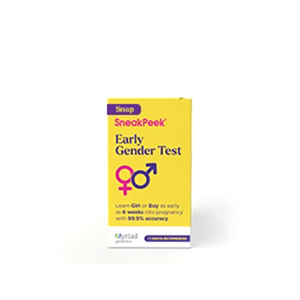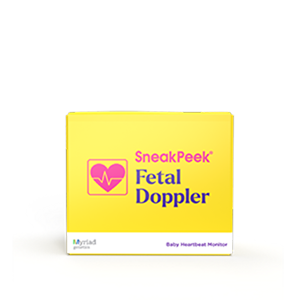Published on April 5th, 2023 and Updated on January 12th, 2024
Check out SneakPeek Gender Test to find out your baby’s gender as early as 6 weeks at over 99% accuracy1!
Shortly after finding out you’re pregnant, you may unexpectedly find yourself diving down the search engine rabbit hole looking for what to do when you find out you’re pregnant. Searching for tips on how to stay healthy and support your little one during the stages of early pregnancy, you begin to notice a trend—everyone seems to be talking about the importance of maternal vitamin D.
But really, how important is vitamin D intake during pregnancy?
Vitamin D concentration lies at the root of your baby’s basic building blocks: their bones, teeth, and nourishment for their overall growth and development. In other words, the nutrient ranks highly on the importance scale. Before you head out to soak up some of the sunshine vitamin for your growing little one, let’s dig into some FAQs about why sufficient vitamin D matters during pregnancy.
What is vitamin D and why is it important?
You may know about the benefits of prenatal vitamins, or are wondering, what are prenatal vitamins? Vitamin D is an essential one to understand. Before making the connection between vitamin D and pregnancy, it’s important to understand what this essential nutrient does for our bodies.
Vitamin D is a fat-soluble vitamin. This means it’s available to our bodies in foods containing fats (rather than ones with predominantly water). We can get our fill of vitamin D from a variety of outlets, including:
- Vitamin D-fortified foods
- Absorbing sunlight through your skin
- Taking vitamin D supplementation
After ingesting vitamin D, your body uses it to absorb and retain calcium and phosphorus—two minerals that play a key role in building and strengthening our skeletal system. Without vitamin D, your body wouldn’t be able to absorb calcium, which is the most plentiful substance in our bones.
Calcium deficiency puts us at a higher risk for:
- Brittle or misshapen bones
- Muscle weakness
- Deformities in your joints
Why do you need vitamin D during pregnancy?
Your little one goes through a whirlwind of growth in utero. What began as a tiny ball of cells roughly the size of a poppy seed rapidly expands to the size of an avocado, then a pineapple, and eventually a watermelon!
Since mothers are the gardeners in this scenario, they’re responsible for watering, nurturing, and cultivating these precious bundles. Babies borrow their share of nutrients from their mamas—vitamin D being one of them.
In addition to using vitamin D to grow their bones and teeth, babies also use it to create their own:
- Kidneys
- Heart
- Nervous system
For this reason, it’s crucial to track your vitamin D levels to ensure this foundational nutrient can support your baby’s rapid growth.
Vitamin D Deficiency: What It Is and How to Avoid It
Many women take their daily prenatal vitamin and assume their vitamin D levels are normal—and many of them are. Other women, though, have low amounts in their bodies and may not even know they’re deficient.
A vitamin D deficiency (VDD) is exactly what it sounds like: it means you don’t have enough vitamin D in your body. It’s quite common during pregnancy, with up to 50% of women receiving a diagnosis of a VDD.
VDD is the most common in the third trimester, when it’s crucial to get an adequate supply of calcium to nurture your baby’s bone growth. Without sufficient reserves of vitamin D, you and your baby could be at risk of:
- Preeclampsia – Women with low vitamin D levels during the second trimester may have a higher risk of being diagnosed with preeclampsia, a blood pressure condition that’s attributed to low birth weight, preterm birth, and placental abruption (when the placenta dislodges from the uterus).
- Low birthweight – Some babies with low vitamin D levels are born with minimal bone density and size, leading to a lower weight when they’re born.
- Congenital rickets – Rickets occurs when infants are born with soft or weak bones, often due to VDD.
- Bone fragility – VDD can cause babies to be born with fragile bones due to a lack of bone density. This makes them more likely to experience potential bone fractures later.
Certain factors may put you at a higher risk of a vitamin D pregnancy deficiency. These include:
- Pregnant mothers with limited exposure to sunlight – Certain parts of the world get significantly less sunlight than others. Women in these locations (and women who don’t often go outside) aren’t able to receive enough vitamin D via daily exposure to UVB rays.
- A darker skin pigmentation – The darker your skin is, the more melatonin it has. Melatonin acts as your body’s natural sunscreen, absorbing a lot of the sun’s rays before the cholesterol can convert it to vitamin D. In this way, people with darker skin typically don’t absorb as much UVB rays as people with lighter skin.
- Obesity – Body fat stores much of your vitamin D. If you’re a person with a higher body mass index (BMI), it can be harder for your body to access that stored vitamin D for essential purposes, like strengthening bones.
How much vitamin D do you need during pregnancy?
Typically, pregnant women receive about 400 international units (IU) of vitamin D in your daily prenatal vitamins. But is that enough to ensure your little avocado or pineapple will grow at a healthy rate?
The suggested dose of daily vitamin D during pregnancy used to be 600 IU, but recent studies suggest taking a higher amount could help mom and baby retain a more adequate amount. Rather than 600 IU, the Committee on Nutrition of the American Academy of Pediatrics states that mamas-to-be and their unborn little ones might benefit from taking up to 4,000 IU of vitamin D each day while pregnant and breastfeeding.
That’s not to say we recommend jumping on the bandwagon without speaking to your OBGYN first. Be sure to consult with your prenatal team before making any significant changes to your vitamin D consumption—they’ll be able to recommend a dosage that works best for you and your little one.
Naturally-derived sources of Vitamin D
4,000 IU of vitamin D may sound like a lot, especially when your prenatal vitamin only provides 400 IU. If you plan to get all 4,000 IU (or even half that), where can you expect to find all that vitamin D lying around?
#1 Food
Vitamin D may not be found naturally in a lot of food items, but if you enjoy a nice salmon filet, you can eat your way toward achieving your daily dose.
Alternatively, you could try:
- Cod liver oil
- Salmon
- Swordfish
- Tunafish
- Sardines
If you’re not a fan of seafood or you’re worried about the “surf” side of the menu while you’re pregnant, there are plenty of other foods that contain vitamin D. These include:
- Beef liver
- Egg yolk
- Fortified cereals
- Fortified milk
- Orange juice fortified with vitamin D
#2 Sunlight
Not only is sunlight linked to giving you better quality sleep (and that’s not always easy to come by during pregnancy), but it’s also another excellent source of vitamin D—and it’s an easy one to track down!
When you step outside to get some fresh air, your skin is exposed to the sun’s ultraviolet B (UVB) rays. When these reach your skin, they come into contact with the cholesterol in your skin cells. The cholesterol absorbs the UVB rays and converts them into vitamin D your body can use to absorb calcium and phosphorous.
The amount of vitamin D you receive from sunlight depends on a few key factors, such as:
- Time of year
- Time of day
- Latitude
- Altitude
- Skin pigmentation
- Sunscreen use
Studies state that your body is most efficient at converting the rays to vitamin D during midday. This makes your lunch break or afternoon walk a perfect time to soak in some rays, allowing for a healthy dose of fresh vitamin D production in your body, for you and your growing baby.
What about vitamin D supplements?
Taking supplements is another efficient method of ensuring your body has enough vitamin D for you and your baby. You can find two different types of supplemental vitamin D pills at online retailers or in stores:
- Vitamin D2 – Ergocalciferol, better known as vitamin D2 is made with plant-based ingredients like mushrooms, which naturally contain vitamin D.
- Vitamin D3 – D3, otherwise known as cholecalciferol, is made with animal ingredients, such as fish oil. Since our bodies naturally produce vitamin D3, this supplement provides us with almost twice as much as D2.
If you’re interested in taking supplements, just be sure to speak with your OBGYN healthcare professional so they can suggest a dosage that’s right for you. With that information, you can tailor how many supplements to take each day to ensure you’re taking a safe amount.
Track Your Vitamin D Levels with SneakPeek
Luckily, there are plenty of ways to supply your baby with the vitamin D they need at their most critical stages of growth. The challenging part? Staying on top of your levels as your pregnancy progresses.
With the SneakPeek Vitamin D Test, you can track your vitamin D levels so you know exactly where they stand at every point along your pregnancy. With convenient at-home testing and a results turnaround of 3 to 6 days, you won’t have to travel to your MD’s office to find out.
With SneakPeek, your results are processed in CLIA-certified labs and reviewed by board-certified, independent physicians who deliver results you can trust. Keep an eye out as this test will be launching soon!
SneakPeek’s Prenatal Wellness tests are designed specifically for pregnant women to help them stay on target throughout those 9 months. Whether you’re looking for a gender blood test or any other SneakPeek test, we have the tools to help you along your pregnancy journey. Join over 1 million moms who trust SneakPeek Test.
This post has been reviewed for accuracy by the following medical professional:
Dr. Heather Soper, Certified Nurse Midwife
Dr. Heather Soper brings over 15 years of experience in women's health and obstetrics to her role as the owner of The Genesis Resort for Birth. Complementing her clinical practice, she serves as an Assistant Professor of Nursing at James Madison University, where she educates nursing students with a focus on compassionate, patient-centered care. Her advanced training and dedication to midwifery are evident in her contribution to both academia and the wellness of expectant mothers
Sources:
- NIH. The Role of Vitamin D in Pregnancy and Lactation: Emerging Concepts. https://www.ncbi.nlm.nih.gov/pmc/articles/PMC4365424
- Harvard University School of Public Health. Vitamin D. https://www.hsph.harvard.edu/nutritionsource/vitamin-d/
- Mayo Clinic. Vitamin D. https://www.mayoclinic.org/drugs-supplements-vitamin-d/art-20363792
- NHS. Week-By-Week Guide to Pregnancy. https://www.nhs.uk/start4life/pregnancy/week-by-week/1st-trimester/week-4
- Cleveland Clinic. Vitamin D Deficiency. https://my.clevelandclinic.org/health/diseases/15050-vitamin-d-vitamin-d-deficiency#symptoms-and-causes
- Tommy’s. Vitamin D in Pregnancy. https://www.tommys.org/pregnancy-information/im-pregnant/nutrition-in-pregnancy/vitamin-d-pregnancy
- ACOG. Vitamin D: Screening and Supplementation During Pregnancy. https://www.acog.org/clinical/clinical-guidance/committee-opinion/articles/2011/07/vitamin-d-screening-and-supplementation-during-pregnancy
- Select Health. 7 Health Benefits of Sunlight. https://selecthealth.org/blog/2020/07/7-health-benefits-of-sunlight
- NIH. Sunlight and Vitamin D. https://www.ncbi.nlm.nih.gov/pmc/articles/PMC3897598/
- NIH. Vitamin D Status and Sun Exposure in India. https://www.pubmed.ncbi.nlm.nih.gov/24494046/
- Healthline. How Much Vitamin D Should You Take For Optimal Health? https://www.healthline.com/nutrition/how-much-vitamin-d-to-take#What-is-vitamin-D?
- NIH. Implications of Vitamin D deficiency in Pregnancy and Lactation. https://www.ncbi.nlm.nih.gov/pmc/articles/PMC3540805
- Cureus. Maternal Vitamin D Levels and Its Correlation With Low Birth Weight in Neonates: A Tertiary Care Hospital Experience in Saudi Arabia. https://www.cureus.com/articles/54013-maternal-vitamin-d-levels-and-its-correlation-with-low-birth-weight-in-neonates-a-tertiary-care-hospital-experience-in-saudi-arabia
- Nature. Vitamin D Deficiency During Late Pregnancy Mediates Placenta-Associated Complications. https://www.nature.com/articles/s41598-021-00250-5
- Cleveland Clinic. Preeclampsia. https://my.clevelandclinic.org/health/diseases/17952-preeclampsia#outlook–prognosis
- NIH. Vitamin D Supplementation During Pregnancy: An Overview. https://pubmed.ncbi.nlm.nih.gov/32487800/
- Baby Center. Vitamin D During Pregnancy. https://www.babycenter.com/pregnancy/diet-and-fitness/vitamin-d-in-your-pregnancy-diet_661#articlesection5

Shop Our Products
SneakPeek aims to provide the most accurate and up-to-date information to help our readers make informed decisions regarding their health before, during, and after pregnancy. This article was written based upon trusted scientific research studies and/or articles. Credible information sources for this article are cited and hyperlinked.






